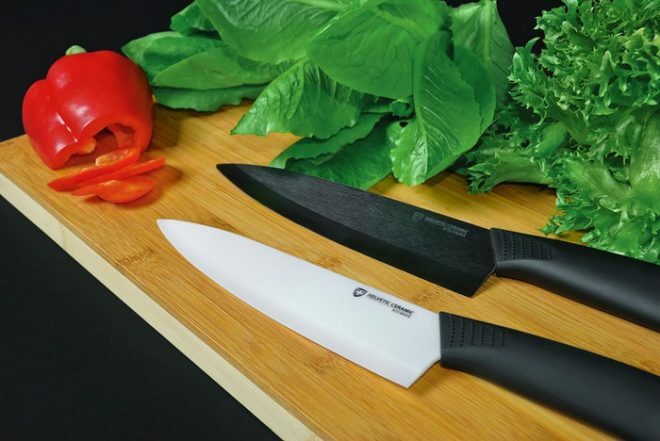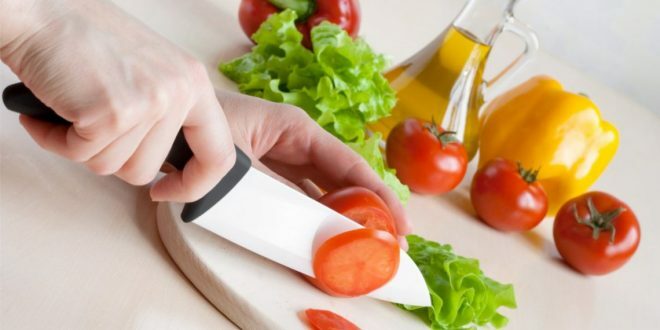The knife is an indispensable tool in the kitchen, and today they are made from different materials. Recently, ceramic knives have gained popularity, they have an attractive appearance and a sharp blade. It is much easier to cut food with such a device, but it, like a steel one, requires sharpening. Sharpening of ceramic knives can also be carried out at home, but first we will consider their properties and features.

Properties and features of ceramic knives
The main feature of ceramic knives is that they are both sharp and brittle. With proper use, it will last for many years.
Attention! Earned on our website kitchen designer. You can familiarize yourself with it and design your dream kitchen for free! May also come in handy wardrobes designer.
Advantages of ceramics:
- Sharpness. The ceramic blade is composed of zirconium dioxide, which is the third strongest material after diamond and corundum. When used correctly, the blade stays sharp for a long time and may not need sharpening for up to three years.
- Neutrality. Such a kitchen appliance, unlike a metal one, has absolutely no effect on the taste of food. It is environmentally friendly, therefore it is recommended to use it for preparing food for children.
- Ease. The ceramic knife is lightweight, which allows you to cut a lot of food quickly and without feeling tired in your hand.
- Resistant to chemical degradation. Metal blades can stain and rust over time; this will not happen with ceramics. They can be washed with any detergent, they are not afraid of contact with hot water.
- Scratch resistant. The device retains its original appearance for several years, it is almost impossible to scratch it.
Disadvantages of ceramics:
- Fragility. The metal blade can cut bones or other hard products. Even if you try to bend it in your hand, it is extremely difficult to break it. Ceramics, on the other hand, is a rather fragile material; it is enough to bend it with your hands and it will break. If you cut bones or try to open a jar with such a blade, pieces can break off from it.
- Price. Ceramics are much more expensive than metal, so a ceramic device will cost much more than a metal one.
- Not versatility. The knife is useful in the kitchen, convenient for cutting vegetables, fruits, meat, but you need to be careful with it. In addition, it is not suitable for hiking, such a device cannot be taken on the road.
- Difficult sharpening. Some people think that ceramic blades cannot be sharpened or can be sharpened, but only at the manufacturing plant. In fact, this can be done even at home, but adhering to some rules.
Ceramic knife sharpening methods
A ceramic knife does not require frequent sharpening, but nevertheless, after a while, it loses its sharpness. Many people do not know how to sharpen a ceramic knife at home, and, in general, whether it is possible to sharpen ceramic knives. In fact, you can sharpen the blade yourself at home in several ways.
Sharpening methods:
- Electric grinder;
- Electric sharpener;
- Hand sharpener;
- Diamond paste;
- Bar;
- Musat;
Electric grinder
You can sharpen a knife in a workshop, in Moscow the price of this service is 200-250 rubles. If you have sharpening skills, then get an electric grinder and two diamond-coated grinding wheels, one 80 microns, the other 40 microns. The machine must work at low speed, the blade must not be pressed against the circle, the sharpening angle must be 20-25 degrees. If you make the angle smaller, the blade will become more fragile. This method should be used only if you have the appropriate skills, otherwise, there is a great chance of damaging the device.
Electric sharpener
The electric sharpener has two diamond-coated discs. You just need to insert the blade into the hole according to the instructions. The sharpener is powered by a rechargeable battery or batteries, it automatically adjusts to the thickness of the blade. Sharpening takes place quickly and professionally, and such devices are also able to remove small chips.
Hand sharpener
A manual sharpener for sintered knives operates on the same principle as an electric one. The sharpening angle has already been adjusted in it, but it is necessary to insert the blade into the hole and sharpen it with smooth movements. This is one of the economical, simple and effective ways.
Diamond paste, bar and circle
The diamond paste contains inclusions of diamond dust and is easy to use. You need to put it on a piece of cardboard and start wiping the blade, this method takes time and patience, but the result is worth it.
For manual sharpening, you can also purchase a diamond-coated stone. It is made in the form of a nail file. The knife must be put on a stand, and then sharpened with a bar across the blade. The angle must be determined by yourself, so this method is recommended for those with experience in sharpening.
Musat
This method allows you to sharpen a blade that is not very dull: the musat does not sharpen, but simply maintains the sharpness of the blade. It is necessary to take a knife in one hand, musat in the other. It must be held vertically. The sharpening motion should be smooth, without strong pressure, otherwise the blade may be damaged.
Rules, following which, you can extend the life of a ceramic knife
In order not to wonder how to sharpen a ceramic knife after a year of use, and not break it, you need to adhere to some recommendations:
- Do not use it to cut frozen meat or bones, or hard vegetables.
- Do not drop the knife on hard surfaces, or in the sink.
- Use it only on a wooden or plastic board.
- Don't wash it in the dishwasher. It is advisable to wash with warm water with detergent, you can use bleaching detergents.
- Do not bend it with your hands, it is very fragile.
- Do not hold the blade over an open flame, as this can damage the handle, because ceramics allows heat to pass through.
- Do not use it to open cans, crush garlic, or peel walnuts.
- It must be stored separately from metal devices; it is advisable to use a special holder.
- You need to cut the food smoothly, do not hit the board hard with the blade.
Ceramic knives cannot be called universal, and in some situations you will still have to turn to a regular metal knife. But, despite this, ceramics have many advantages, so such devices are still popular. Such a knife is useful for those who cook a lot, because it is lightweight and convenient. Its fragility will not be a problem if you follow all the rules of operation and know how to sharpen a ceramic knife at home.
Video: rules for caring for kitchen knives
average rating 5 / 5. Number of ratings: 1
No ratings yet. Be the first to rate.
